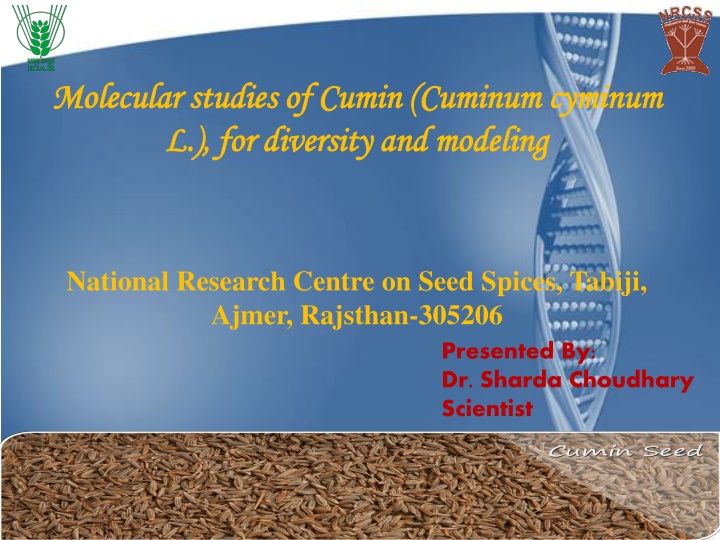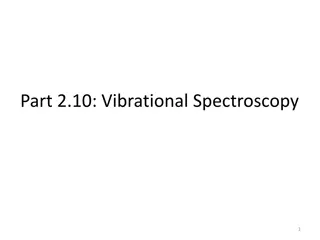Molecular Studies of Cumin for Diversity and Modeling
Cumin (Cuminum cyminum L.) is a valuable seed spice with medicinal properties, belonging to the Apiaceae family. This herbaceous plant is locally known as Zeera and cultivated mainly in India. Molecular studies, using markers for genetic improvement, are crucial for enhancing the quality and variety of seed spices, benefiting farmers economically and pharmaceutically.
Download Presentation

Please find below an Image/Link to download the presentation.
The content on the website is provided AS IS for your information and personal use only. It may not be sold, licensed, or shared on other websites without obtaining consent from the author.If you encounter any issues during the download, it is possible that the publisher has removed the file from their server.
You are allowed to download the files provided on this website for personal or commercial use, subject to the condition that they are used lawfully. All files are the property of their respective owners.
The content on the website is provided AS IS for your information and personal use only. It may not be sold, licensed, or shared on other websites without obtaining consent from the author.
E N D
Presentation Transcript
Molecular studies of Cumin ( Molecular studies of Cumin (Cuminum L.), for diversity and modeling L.), for diversity and modeling Cuminum cyminum cyminum National Research Centre on Seed Spices, Tabiji, Ajmer, Rajsthan-305206 Presented By: Dr. Sharda Choudhary Scientist
Introduction Introduction Seed spice crops are the commercial crops grown by the poor farmers in the arid region of our country. Seed Spices are annual herbs, whose dried seed or fruits are used as spices. These are used for color, aroma, flavor, medicinal properties etc. It is one of the oldest and economically most important seed spice with medicinal properties. Cumin is the most important and crucial, of all.
Cumin Cumin Cumin (Cuminum cyminum L.) is a valuable seed spice belonging to the family Apiaceae. It is a herbaceous, dicotyledonous annual plant, diploid (2n = 2x = 14) belongs to the family Apiaceae. Cumin is locally known as Zeera in Hindi and is believed to be the native of the Mediterranean and near Eastern regions. In India it is mainly cultivated in Rajasthan, Gujarat and in some parts of Madhya Pradesh, Uttar Pradesh and Tamil Nadu as a rabi crop.
Cumin seeds are preferred for their typical pleasant aroma due to an aromatic alcohol (animol) and spicy taste. It is largely used in mixed spices and curry powders. Inspite of its immense use as seed spice in our routine cooking, recent studies have indicated its pharmaceutical and medicinal importance. Any new technique for the development of these crops will go a long way in improving the livelihood of the poor farmers and bring wealth to the country.
Molecular markers are the vital tool for genetic improvement of crops specially seed spices in which traditional breeding approaches are difficult to produce varieties resistant to various biotic and abiotic stresses. Seed spices remain neglected for one or other reasons, hence limited work for variety development and quality improvement have been done. Marker development for economically important characters is very important to apply biotechnological tools for improvement of seed spices crops.
Molecular Markers Revealing variation at a DNA level Characteristics: Co-dominant expression Nondestructive assay Complete penetrance Early onset of phenotypic expression High polymorphism Random distribution throughout the genome Assay can be automated Molecular markers (identified as genetic markers) are a fragment of DNA that is associated with a certain location within the genome. Molecular markers are used in molecular biology biotechnology to identify a particular sequence of DNA in a pool of unknown DNA. and
It has various applications in agriculture including Seed Spices: Species Identification Genetic variation and population structure study in natural populations Comparison between wild and modified populations Assessment of demographic bottleneck in natural population Propagation assisted rehabilitation programmes. However, there still exists some limitations
Materials And Methods Plant Materials and DNA isolation New protocol for DNA isolation PCR program Gel electrophoresis of the amplified products Reproducibility of amplification patterns Scoring and Data analysis
This graph was derived by CROMA software to derive the sequences. raw Different colors in the graph shows different amino acids. 20 The height of the peaks in the graph determine the amino acid to be selected Chromatogram showing nucleotide sequences for cumin protein gq33
Physiochemical properties The physiochemical properties for gq33 cumin protein were identified using Protparam. Secondary Structure For the prediction of secondary structure of protein FASTA sequence were used and prediction was performed using GOR IV, SOPMA, ProFunc and PDBSum.
Three Dimensional Structure The modeling of the three dimensional structure of the protein was performed by ab-initio and threading Meta servers. MEMSAT-SVM MEMSAT-SVM was used to identify a channel in fenugreek
RESULTS AND DISCUSSION
In the present study, genetic similarity was assessed among fifty five cumin accessions, analysis of the data using 20 RAPD primers showed that 15 primers generated bright and reproducible amplified products which detected polymorphism among the accessions used. Fifteen RAPD primers showed clear bands and polymorphism on profiling. This indicates very low level (47%) of genetic diversity among genotypes. Cluster analysis based on the resulting data was performed using UPGMA method and Dice's similarity coefficient by NTSYS software.
(a) 3D Plot (b) Line Graph, showing cluster analysis conducted by the software NTSYS-pc version 2.00























